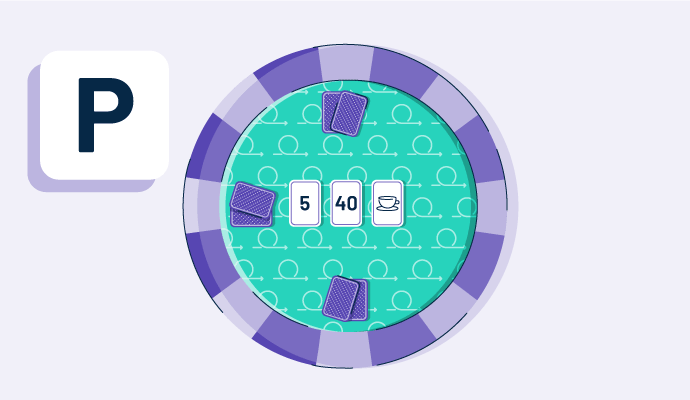What is planning poker?
Planning poker is a collaborative estimation method teams use to determine the time and effort involved in a project or task. Popular among agile software development teams, planning poker ensures all team members have a voice, contributing to accurate work estimations.
Also known as scrum poker, planning poker gets its name from the cards team members use for the game. These individual cards each display a number that represents the number of story points or effort units required for a specific task.
Agile teams play the game after determining the product backlog or list of deliverables. To ensure the most accurate estimates, a variety of team members participate, from user experience (UX) designers to developers.
While teams often play planning poker with physical cards, many product development teams prefer using software or apps to connect remotely. Some project management tools include a planning poker feature.
The planning poker process
The process is the same whether a team plays planning poker with tangible or digital cards.
.png)
After the product backlog is created, the instructions are as follows:
- Distribute cards. Each participant starts with an identical deck of numbered cards. Teams can choose which numbers the cards contain, but they can't have two of the same number in the deck. Some teams use a number sequence that doubles each time; other teams prefer numbers based on the Fibonacci sequence. By using a varied number system, team members find it easier and more efficient to choose a value for each task.
- Read the backlog item. The game facilitator, typically the product owner or manager, reads or explains the user story or task to the team.
- Discuss the product. Team members talk about the item, sharing their perspectives about what’s involved and any obstacles they foresee. During this portion, they may also ask clarifying questions to better understand the demands of the user story, like, “How many people do we need to complete this task?” or “What approach or method would we use here?”
- Estimate and reveal. Once all participants are confident about the scope of the task, each team member selects the card from their hand with the number representing the story points required for the task. The higher the number, the more effort they anticipate the task taking. Players wait to reveal their selection until everyone is ready to avoid influencing other players.
- Come to a consensus. If all of the values shown are the same, that number becomes the group’s consensus, and it’s recorded by the game facilitator. If the cards differ, the group continues its discussion, and participants try to convince each other of their opinion. Players vote again by either keeping their previous card or choosing a new one.
This process is repeated for each user story. The team then plans the sprint using accurate estimates of how long each task will take.
Benefits of planning poker
Planning poker is an engaging way to prepare for sprints and encourage collaboration. Some specific advantages include:
- Increasing team alignment and buy-in. Team members discuss openly during a game of planning poker and work toward a consensus, creating ownership and engagement. This also cultivates a more collaborative, cooperative workplace culture.
- Creating more accurate estimates. Planning poker draws from people with different product development roles and a wide range of knowledge. This leads to better estimates and a smoother, time-sensitive development period, also known as a sprint.
- Identifying and mitigating risks. Planning poker involves asking questions and discussing tasks in detail, giving the team an early opportunity to consider potential obstacles. Once they bring these issues to light, the team can take steps to avoid them.
- Making prioritization easier. In planning poker, teams estimate time and effort on a task relative to others they’ll complete. During a sprint, this makes it easy to prioritize user stories that need more resources and attention.
Planning poker best practices
When done well, planning poker sets teams up for a successful sprint and on-time product delivery. To maximize their success, a team should consider these best practices.
- Establish group norms for discussion. Sometimes group discussions become imbalanced because some members have more seniority and experience than others. On the other side of the coin, team members agree with each other simply to minimize conflict. To avoid this, the team should set and review norms before each game of planning poker.
- Calibrate. Teams should look at previous user stories to create a frame of reference and accurately calibrate their estimates with each other. The team should select fresh stories every month or two because the amount of time a task takes changes over time.
- Stop when the team is tired. By the end of a game of planning poker, team members may be less willing to discuss and more likely to argue. Even if only a few backlog items remain, the team will produce more accurate estimates if they wait to resume the game until after everyone’s had a break.
Learn more about best practices in the agile methodology and how using it can help your team.

Kelly Fiorini
Kelly Fiorini is a freelance writer for G2. After ten years as a teacher, Kelly now creates content for mostly B2B SaaS clients. In her free time, she’s usually reading, spilling coffee, walking her dogs, and trying to keep her plants alive. Kelly received her Bachelor of Arts in English from the University of Notre Dame and her Master of Arts in Teaching from the University of Louisville.











